The Plan
Most of the travelers we met in Ulaan Baatar were in-between trains on the way to either Moscow or Beijing. It seems that for most travelers Mongolia is less of a destination than a stop over on the Trans-Siberian railway. Depending on their schedules some stayed for as little as one day, while others gave it a few weeks. In any case, it usually wasn't enough time to get to the western part of Mongolia...which looked utterly amazing in Idre's (the guesthouse and tour company owner) online photo albums. Combine that with the idea that slipping out the backdoor from Mongolia into Kazakhstan sounded incredibly interesting and, now, we had ourselves a loose plan.

We decided to book our tour through Idre. Not only did he come highly recommended by Fitz and Kimber, but he was also one of the more reasonably priced operators in town. There were three main reasons we took the tour rather than heading out on our own: the car, the driver, and the guide.
The car is recommended because there is very little public transport in the country and what little there is only connects major towns. Hitchhiking is an option, but it would take ages to get from place to place and some of the more remote and interesting spots would be next to impossible to reach. A car or van (in our case) allows you to go where you like, when you like.
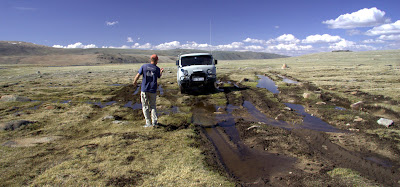
The driver is recommended because the roads in Mongolia are not actually roads at all, but rather paths across the country that are driven on more often than the dirt, sand, rocks or grass next to them. There are no accurate maps of these "roads" and you could probably count the number of road signs in the country on one hand. To navigate in Mongolia you have to have a good memory, a good sense of direction, a good personality and willingness to ask everyone you meet for directions, and of course, lots of luck.
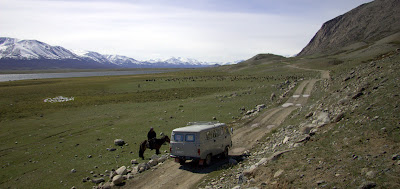
Asking Directions in the Altai Range
The guide is recommended because most people outside of Ulaan Baatar do not speak English. In the countryside your lodging options involve either staying with families in their home or camping. Therefore, a translator is invaluable. Staying with the families and learning about the country and people through interacting with them turned out to be the very best part of the entire trip. Another great reason for a guide is food. I will go more into food later, but having a guide who knew western tastes and who was familiar with local resources was a huge bonus.
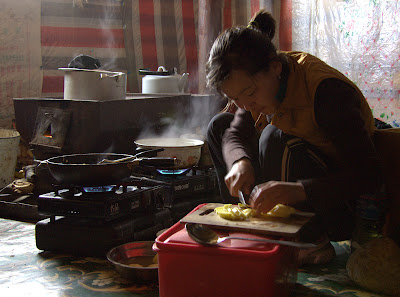
At $53 per person per day, it was well worth it. The hard part of the trip, as it turned out, was picking what to see and what to skip in order to make it to Olgii at the other end of the country in 30 days (Mongolia is about twice the size of Texas in area). We choose to skip a good portion of the southern Gobi desert for a more northerly route of grasslands or steppes, mountain forest steppes, and alpine regions. Our planned departure date was May 3rd and we planned on flying out of Olgii on June 6th.
The Guide
Our guide was Khishgee Namjildorj, who we were super happy to get. She was the girl that helped me to retrieve my "lost" bag when we first arrived. Not only was she very helpful, friendly and funny, but cute too. Orginally from Erdenet in the north, she had been living in Ulaan Baatar for the last 3 years. Her English was excellent as she had spent some time working for an American couple doing NGO work. Among her many lives, she had also been a bee keeper.
Khishgee was single and pushing 30 years old. According to her, women of that age are considered about as old as dirt in Mongolia. She had the very western view that her life was hers and that it should be used to her best interest. However, she was still dealing with very strong pressures from family and friends to marry...SOON! Her preference was to move to the United States to continue her English studies, but her first visa application had been rejected. She plans to re-apply in the fall.
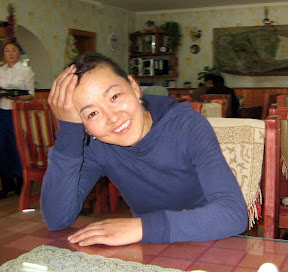
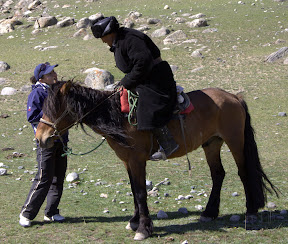

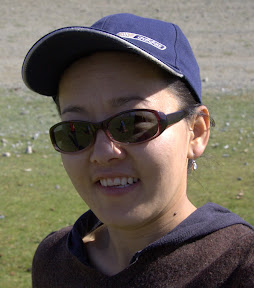
I think Khishgee was a little apprehensive of being our guide at first. Not because I'm scary... which I can be. She was plenty brave...except for an irrational fear of cats, a slightly less irrational fear of dogs, and a blood curdling fear of spiders. No, she had just returned from a 6 day trip and had no desire to do 31 day trip. We were a little worried but happy when Idre strongly suggested she take us. As it turns out she was the uberguide, always making sure we were ok, well fed, and happy. She also got damn good at Rummy 500.
The Car & Driver
Birah Saikan was our driver. He was a true charmer. 37 years old with a wife and two kids back in Ulaan Baater. He seemed to have a girlfriend in every town no matter how big or small, although he insisted (and Khishgee confirmed) that he was completely faithful to his wife. In reality, he was just an incredibly congenial guy that would meet people everywhere. Male or female, they instantly became like long-time friends gathering around to chat about the condition of the roads, the health of their animals, or the current state of the van. Anyway... he always had a smile on his face, and although he spoke very little English, he understood plenty and was always able to make himself understood. When ever we stopped for a day or so, Birah would basically pull the van apart clean the bits and put the whole thing back together again... just to make sure everything was still working well.
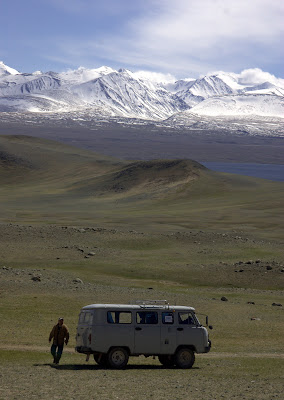

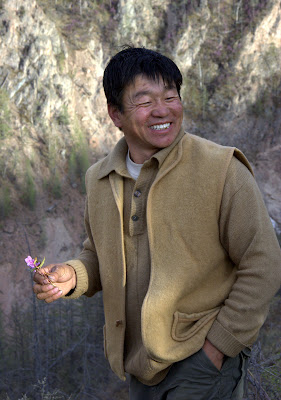
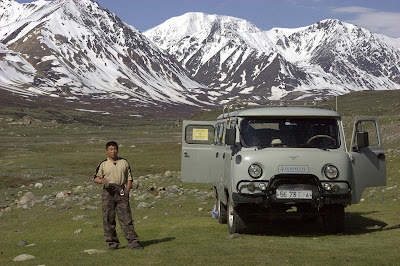
The van was a battleship grey Russian make of which I forgot to write down. What looked like a slightly more stout version of the VW van, turned out to be quite adept at nagivating even the nastiest roads Mongolia...although we were never really sure how much slope and speed it would take to tip the machine over. The inside was decked out in purple leopard skin seat covers and a stack of matresses on Suwei's side so that she didn't have to worry about her feet not touching the floor. The thing reeked of petrol and we came up with a number of solutions to keep the one little window in the back open including: knitting yarn, rubber bands and finally the elastic strap off my day pack. We would travel about 150 kms a day (that's about 90 miles for the Americans that can't convert) and depending on the condition of the road, we would either spend the time napping, listening to the iPod, holding on for dear life or some combination thereof.
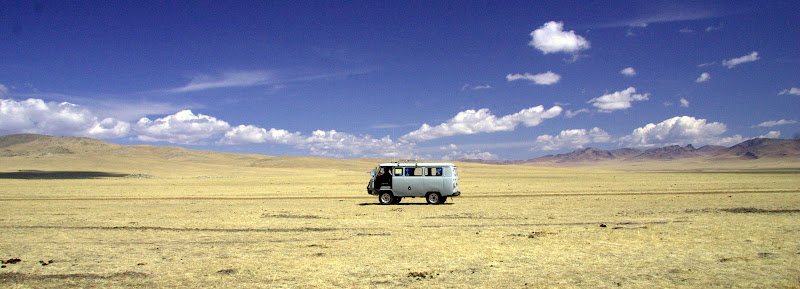
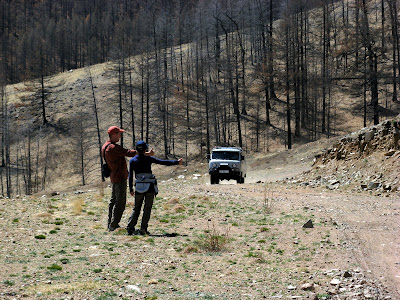

The Gers
Each evening before dark, we needed to find a place to stay for the night. During the first week of our trip we mostly stayed with families that either Khishgee or Birah already knew from previous tours. Further out we would select gers by how many kids stuck their heads out the door or by the amount of goat poop around it. We would drive up and honk our horn. Someone would peak out of the door looking like they just woke up and wander out to chat with Khishgee. They always seemed to look disgruntled and not all that pleased to see us. But after 2 minutes of chatting with Khishgee, they would smile and invite us in for the traditional Mongolian tea, a salty milk tea, and snacks (usually a combination of stale deep fried donut bits, extremely hard yogurt-like cheese, dry bread, cookies, candies, yak butter, and sugar cubes).

The gers are all organized in a similar manner with a few variations. The doors almost always face south as the winds tended to blow down from the north. You have to stoop to go inside as the doors were never more than 4 feet high. To the left of the door is where you store your gear, saddle, goat combs, rope and maybe a stack of suitcases you received when you were married. Next, you come to the first bed -- either hammock-like or rock hard (we opted to sleep on the floor in most cases). At the back of the ger you usually find a combination of 1 or 2 dressers and a bed or futon type couch. The dressers are painted in the same orange and blue pattern as the front door. On top of the dressers is a mirror lined with photos showing your family in front of the Sukhbaatar Statue in UB or with thier best horses. In most cases you will also have a ceramic statuette of two horses sparring. This is also where the television (usually black and white), satellite dish controller, and car battery will be placed. In the afternoons in May, your family will be huddled around that tv watching Sumo wrestling. To the right of the dressers and just before the third bed is where you put your sack of dried meat. To the right of the bed is the kitchen...and now you have come full circle and are back at the door. In the center is a the wood burning stove, a small table and a few shin high stools. The floor is covered with a mix of oriental carpets, linoleum, and grass. The walls are also sometimes covered with oriental carpets for extra insulation.
Kazak gers in the west of Mongolia are taller and have the stove towards the back of the Ger. The consistency is amazing. We were watching an old Mongolian movie on tv one night and the inside of the ger in the movie was almost exactly the same...minus the tv playing the movie of course.
In the countryside, all of the above get packed up and moved 3 or 4 times a year. Most of the families we stayed with said they were planning thier summer move in mid-June.
The Food
After reading the Lonely Planet Mongolia guide on the train from Beijing, we came to Mongolia expecting a diet of nutton but mutton...as I dubbed it or mutton, mutton, mutton as the guide put it. We were pleasantly surprised when Khishgee whipped up the first meal and saw that it was rife with veggies. That's not to say that we didn't get plenty of mutton along the way. The Mongolian diet consists of a few simple staples and just about all Mongolian dishes can be created with a combination of meat, rice, flour and potatoes. When we ate with the families or in restaurants, we would usually get a bowl of either rice or noodles with gristly, fatty chunks of mutton and potatoes spread throughout. This could also be prepared with a broth to make it more soup-like.
Starch too seems to be an important part of the Mongolian diet. We figured there must be some kind of two starch rule as every meal seemed to have at least two (rice & potatoes, noodles & potatoes, potatoes cooked 2 different ways with rice, etc.) We blew the 2-starch rule one night and outdid ourselves with fried pancakes made out of wheat flour (khuushuur) filled with potatoes, rice and onions... and if that wasn't enough... it was served with bread.
By the time we got out west, there wasn't much available to buy in the market. In the last two weeks we became quite impressed by the number of different meals Khishgee was able to conjure up using only pasta, rice, potatoes, meat & carrots. She did a great job, but we were definitely ready for a change of diet by the end of the trip.
The Toilets:
In most case there are none. Mongolians still live a very nomadic lifestyle and there are very few permanent structures, including outhouses. In most cases we ended up crouching behind a rock or one the backside of a grassy knoll, but there were spots where you just had to drop and go in the middle of an open plain and hope that no one comes out of the ger.
Some families were still in thier more permanent winter place and had dug pit toilets. These were usually a two foot hole with wood planks over the top of it. For privacy there was usually a 3 foot high wall made out of stacked logs.
In town there was usually a pit toilet, deeper than in the country and with a wood shack for privacy (no half moon carved into the door though). The only western style toilets you will find are in Hotels and some restaurants. After one month we had some strong thigh muscles.
Coming up next
The above summary is obviously an over simplification. For many more details about the families and places we visited, please stay tuned. We have 4 more posts on deck full of photos and stories from our 30 days on the road.
No comments:
Post a Comment